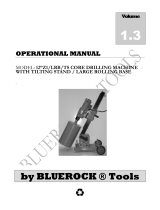
c) Do not expose power tools to rain or wet condi-
tions. Water entering a power tool will increase the
risk of electric shock.
d) Do not abuse the cord. Never use the cord for
carrying, pulling or unplugging the power tool.
Keep cord away from heat, oil, sharp edges or
moving parts. Damaged or entangledcords increase
theriskofelectricshock.
e) When operating a power tool outdoors, use an
extension cord suitable for outdoor use. Use of
a cord suitable for outdoor use reduces the risk of
electric shock.
f) If operating a power tool in a damp location is
unavoidable, use a residual current device (RCD)
protected supply. Use of an RCD reduces the risk
of electric shock.
4.1.3 Personal safety
a) Stay alert, watch what you are doing and use
common sense when operating a power tool. Do
not use a power tool while you are tired or under
the influence of drugs, alcohol or medication. A
moment of inattention while operating power tools
may result in serious personal injury.
b) Use personal protective equipment. Always wear
eye protection. Protective equipment such as dust
mask, non-skid safety shoes, hard hat, or hearing
protection used for appropriate conditions will reduce
personal injuries.
c) Prevent unintentional starting. Ensure the switch
is in the off‐position before connecting to power
source and/or battery pack, picking up orcarrying
the tool. Carrying power tools with your finger on the
switch or energising power tools that have the switch
on invites accidents.
d) Remove any adjusting key or wrench before turn-
ing the power tool on. Awrenchorakeyleftat-
tached to a rotating part of the power tool may result
in personal injury.
e) Do not overreach. Keep proper footing and bal-
ance at all times. This enables better control of the
power tool in unexpected situations.
f) Dress properly. Do not wear loose clothing or
jewellery. Keep your hair, clothing and gloves
away from moving parts. Loose clothes, jewellery
or long hair can be caught in moving parts.
g) If devices are provided for the connection of dust
extraction and collection facilities, ensure these
are connected and properly used. Use of dust
collection can reduce dust-related hazards.
4.1.4 Power tool use and care
a) Do not force the power tool. Use the correct
power tool for your application. The correct power
tool will do the job better and safer at the rate for
which it was designed.
b) Do not use the power tool if the switch does not
turn it on and off. Any power tool that cannot be
controlled with the switch is dangerous and must be
repaired.
c) Disconnect the plug from the power source
and/or the battery pack from the power tool
before making any adjustments, changing
accessories, or storing power tools. Such
preventive safety measures reduce the risk of
starting the power tool accidentally.
d) Store idle power tools out of the reach of chil-
dren and do not allow persons unfamiliar with the
power tool or these instructions to operate the
power tool. Power tools are dangerous in the hands
of untrained users.
e) Maintain power tools. Check for misalignment or
binding of moving parts, breakage of parts and
any other condition that may affect the power
tool’s operation. If damaged, have the power tool
repaired before use. Many accidents are caused by
poorly maintained power tools.
f) Keep cutting tools sharp and clean. Properly main-
tained cutting tools with sharp cutting edges are less
likely to bind and are easier to control.
g) Use the power tool, accessories and tool bits etc.
in accordance with these instructions, taking into
account the working conditions and the work to
be performed. Use of the power tool for opera-
tions different from those intended could result in a
hazardous situation.
4.1.5 Service
a) Have your powertoolservicedby a qualified repair
person using only identical replacement parts.
This will ensure that the safety of the power tool is
maintained.
4.2 Proper organization of the work area
a) Approval must be obtained from the site engineer
orarchitect prior tobeginningdrillingwork. Drilling
work on buildings and other structures may influence
the statics of the structure, especially when steel
reinforcing bars or load-bearing components are cut
through.
b) When drilling through walls, secure (cordon off)
the area behind the wall, as material or the core
may fall out on the other side of the wall. When
drilling through ceilings, secure (cordon off) the
area below as drilled material or the core may
drop out and fall down.
c) In order to avoid accidents in which persons fall
and injure themselves, the opening that is created
must be securely and visibly cordoned off.
d) Place the mounting device on a solid, flat and level
surface. If the mounting device can slip or wobble,
the machine cannot be guided smoothly and safely.
e) Check the nature of the surface. Rough surfaces
may reduce the holding power of the drill stand.
Coatings or composite materials may pull away from
the surface while you are working, so that the drill
stand with the core drilling machine are no longer
held securely.
f) Do not overload the mounting device and do not
use it as a substitute for a ladder or platform.
Overloading the mounting device or standing on it
may shift its center of gravity to a higher position,
causingittotipover.
en
26
Printed: 07.09.2015 | Doc-Nr: PUB / 5209045 / 000 / 02






















